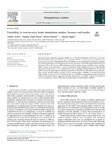Variability in non-invasive brain stimulation studies: Reasons and results

Non accesible ata 9999/99/99
Use este enlace para citar
http://hdl.handle.net/2183/35409Coleccións
- Investigación (CCDEF) [298]
Metadatos
Mostrar o rexistro completo do ítemTítulo
Variability in non-invasive brain stimulation studies: Reasons and resultsData
2020-02-06Cita bibliográfica
Guerra, A., López-Alonso, V., Cheeran, B., Suppa, A. (2020). Variability in non-invasive brain stimulation studies: reasons and results. Neuroscience Letters, 719:133330
Resumo
[Abstract]: Introduction: Non-invasive brain stimulation techniques (NIBS), such as Theta Burst Stimulation (TBS), Paired Associative
Stimulation (PAS) and transcranial Direct Current Stimulation (tDCS), are widely used to probe plasticity in the
human motor cortex (M1). Although TBS, PAS and tDCS differ in terms of physiological mechanisms responsible
for experimentally-induced cortical plasticity, they all share the ability to elicit long-term potentiation (LTP) and
depression (LTD) in M1. However, NIBS techniques are all affected by relevant variability in intra- and intersubject
responses. A growing number of factors contributing to NIBS variability have been recently identified
and reported. In this review, we have readdressed the issue of variability in human NIBS studies. We have first
briefly discussed the physiological mechanisms responsible for TBS, PAS and tDCS-induced cortical plasticity.
Then, we have provided statistical measures of intra- and inter-subject variability, as calculated in previous
studies. Finally, we have reported in detail known sources of variability by categorizing them into physiological,
technical and statistical factors. Improving knowledge about sources of variability could lead to relevant advances
in designing new tailored NIBS protocols in physiological and pathological conditions.
Palabras chave
Non-invasive brain stimulation
Transcranial magnetic stimulation
Theta burst stimulation
Paired associative stimulation
Transcranial direct current stimulation
Transcranial magnetic stimulation
Theta burst stimulation
Paired associative stimulation
Transcranial direct current stimulation
Versión do editor
Dereitos
© Elsevier
ISSN
0304-3940
Ítems relacionados
Mostrando ítems relacionados por Título, autor ou materia.
-
Solutions for managing variability in non-invasive brain stimulation studies
López-Alonso, Virginia; Guerra, Andrea; Cheeran, Binith; Suppa, Antonio (Elsevier, 2020-02-06)[Abstract] Introduction: In the last three decades, a number of non-invasive brain stimulation (NIBS) protocols, capable of assessing and modulating plasticity in the human motor cortex (M1), have been described. For ... -
A preliminary comparison of motor learning across different non-invasive brain stimulation paradigms shows no consistent modulations
López-Alonso, Virginia; Fernández-del-Olmo, Miguel; Cheeran, Binith; Sandrini, Marco; Abe, Mitsunari; Cohen, Leonardo; Liew, Sook Lei (Fronteirs, 2018-04-23)[Abstract]: Non-invasive brain stimulation (NIBS) has been widely explored as a way to safely modulate brain activity and alter human performance for nearly three decades. Research using NIBS has grown exponentially ... -
Efectividad de la estimulación eléctrica neuromuscular y la estimulación cerebral no invasiva en el tratamiento de la disfagia post accidente cerebral vascular en las fases aguda o subaguda: una revisión de la literatura
Vázquez Ramil, Inés (2020-06)[Resumen] Introducción. La disfagia es un trastorno que ocurre como una complicación en el 37-78% de los pacientes con accidente cerebrovascular (ACV) y da lugar a problemas graves como la malnutrición, deshidratación, ...





